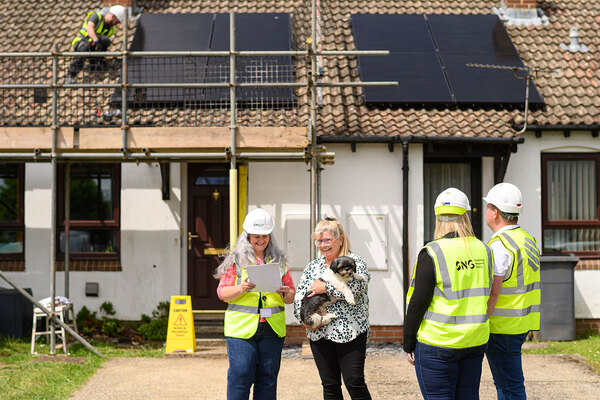Why a skilled workforce is needed to retrofit successfully
People are the most important factor in the sector’s decarbonisation drive. Richard Hughes, partnership development director at contractor Mears, sets out how the skills shortage can be overcome

In association with:
![]()
The housing sector’s drive to decarbonise its stock by 2050 is going to need plenty of resources – and people are perhaps the most important. Without a skilled workforce, there can be no retrofit at the speed and scale required.
The sector, however, is under pressure from both a skills shortage in construction and the rapidly approaching 2050 net zero deadline.
How can housing providers attract and retain the workforce they need to meet this crucial target? Inside Housing spoke to Richard Hughes, partnership development director at repairs and maintenance provider Mears, to find out.
Where does the sector stand in terms of the skills and people it needs to deliver decarbonisation?
We have lost an awful lot of skilled workers over the past few years. Brexit has played a role there. I don’t think that gap has been filled yet, but because government funding for retrofit has been released in significant volumes within the past 24 to 36 months, the sector is now starting to catch up.
The market is currently dealing with the demand for skills, but as retrofit programmes begin to ramp up, we are going to get to a bottleneck when that demand outstrips supply.
That said, there has been plenty of funding and government support for decarbonisation, and that has generated momentum – albeit with a few U-turns and bumps in the road along the way. Within the past two to three years, the Department for Energy Security and Net Zero has delivered a statement of intent with its commitment to longer-term planning.
That is really, really encouraging, and it has given businesses a lot more confidence.
What are the main skills needed to implement retrofit?
The relevant skills today are focused on compliance with PAS 2035 [the British standard for retrofit]. That gives everybody a script to stick to, to ensure that retrofit is as straightforward as possible.
This has created a host of opportunities that are split between soft skills and trade skills.
So what are the main skills that may be needed? We need people to be able to identify and design the right solutions for each property – so that when we do retrofit, we do it once, and we do it properly. That ranges from architectural and design input to building management.
Then, of course, you need people to do the actual retrofit works. That, in itself, presents a host of opportunities, because as well as insulation, it will soon spill into things like district heating, heat pumps and renewables on a greater scale than we have seen so far.
Communication is also becoming a key skill. Being able to get the most from a new piece of kit – an air source heat pump, for example – is as important as the installation itself, and that means ensuring that residents fully understand how to use them.
Together, these core skills – around identifying necessary works, compliance, delivery and communication – represent a huge opportunity, both within the sector and for people leaving education, or for those who wish to diversify their current skill sets.
How prepared is the sector to develop these skills and avoid the coming bottleneck?
What we have seen, positively, is a shift from everyone saying we haven’t got the skills needed, to organisations, academies and universities setting up to provide an environment for people to get those skills.
Almost every educational institution that we’re engaging with is on board. They are putting in the infrastructure, creating working environments for people to learn hands-on, and those courses are continually being developed to a degree that we’ve never seen before. So the future is bright.
Has it happened quickly enough? We will wait and see. I do think academic institutions have seen the size of the prize. But, again, the momentum will come when there are businesses crying out for apprenticeship positions and skilled people in these markets.
We’re starting to approach that tipping point, but we’re not there yet.
What can organisations do today to recruit the workforce they need?
In order to understand the skills they need for retrofit, housing providers need to understand the works required on each of their properties in detail. But landlords, by and large, don’t have the bandwidth for this.
This is where partnership working comes in.
Housing providers should choose a partner that will give good advice, and that will be able to identify the works that need to be done.
They need to find a partner that will get them to their destination regardless of a vested interest in a particular type of technology or solution.
The solutions for any given property can be multi-faceted, but in our experience, social landlords don’t need to manage multiple contractors across a number of different disciplines, even when this is the case. With the pressures housing providers are under, I don’t see that working.
There are organisations out there – and Mears is but one – that will provide a single solution-agnostic service to help landlords understand what’s needed, and which can then go deep into their supply chains to make sure that their delivery partners are providing the necessary skills and workforce.
What should landlords consider before entering into a partnership?
Thinking long term is key. We have just entered into a 26-year partnership with a housing organisation, so it runs until 2050, the deadline for decarbonisation. We will be providing all the usual day-to-day services. What that gives both partners is the chance to work shoulder-to-shoulder and to maximise every opportunity.
Long-term partnering has several benefits. It means lots of touchpoints and access to customers – and that is vital in the context of retrofit programmes.
It gives us time to talk to residents, to become familiar and to build a rapport. We can ask them all kinds of details, such as: is your home draughty? Is there any damp?
We can use that data to inform the retrofit works. This, in turn, gives us that understanding of the skills and workers needed for a particular project.
Long-term partnerships also offer stability. They allow for changes in policy and direction, and they also enable providers to make the best decisions around how and where to invest their funds.
That’s a key consideration, because we can talk about a skills gap, but it wouldn’t exist unless the money is there to make the works possible in the first place.
Recent content in association with Mears
Using data intelligence to accelerate retrofits
Robust data and intelligence can inform retrofit decision-making. Steve Osborne, head of business improvement at repairs and maintenance provider Mears, sets out what landlords need to consider
Using innovation to meet net zero targets
Innovation and technology could be the key if the social housing sector is to meet its net zero targets. Michael McGowan at repairs and maintenance provider Mears explains why
It’s vital to take residents with you on the decarbonisation journey. How can landlords do this?
The drive to net zero asks a number of questions about the landlord-tenant relationship. An Inside Housing roundtable, in association with Mears, looks for some answers
What progress has the sector made to plan and prioritise decarbonisation projects?
A survey run by Inside Housing in association with Mears asked the housing sector about its strategies, priorities and challenges when it comes to achieving net zero carbon











